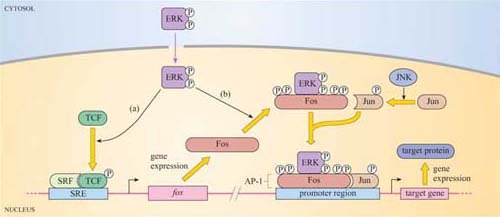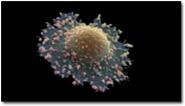3.8 Activation of transcription factors
We have already come across several examples of signalling pathways leading to activation (or inactivation) of transcription factors, which in turn modulate transcription of sets of genes leading to, for example, programs of differentiation or proliferation. You will also meet several other specific examples in subsequent chapters. For now, we shall examine one particular scenario, namely the activation of immediate early genes by MAP kinases, which illustrates some of the principles and details involved.
One of the most important immediate early genes activated by the ERK family of MAP kinases is fos. The fos gene product is itself an important transcription factor, which helps to activate transcription of genes containing binding sites for the transcription factor complex AP-1 (formed by association of Fos and Jun; Figure 45) in their promoters. ERK brings about transcription of fos by phosphorylating the nuclear transcription factor known as ‘ternary complex factor (TCF)’. This, together with the serum response factor (SRF), binds to the serum response element (SRE) in the promoter of the fos gene and increases its transcription rate (Figure 45).

It takes about 30 minutes or more for the proteins encoded by immediate early genes such as fos to be synthesized. Once Fos protein has been produced, MAP kinases participate in its activation, in a stepwise manner, firstly by phosphorylating two sites in the C-terminal region of Fos. This exposes the ERK-binding motif of Fos. ERK then further phosphorylates Fos at two more sites. It is immediately apparent that if MAP kinase activation is only transient, lasting for less than 30 minutes, Fos cannot be activated. Therefore, we can see how transient MAP kinase activation can lead to a different cellular outcome than sustained MAP kinase activation.
This is illustrated by the neural cell line PC12, which fully differentiates them into neurons only when ERK activation is sustained (for example, by addition of nerve growth factor; Figure 40c).
Can you think of an experimental method for the investigation of the relationship between sustained activation of ERK and differentiation of PC12 cells?
By transfection of PC12 cells with constitutively active mutant forms of MEK and analysing neurite outgrowth (Box 3).
